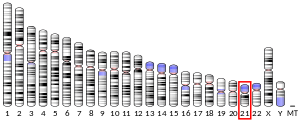Putative tyrosine-protein phosphatase TPTE is an enzyme that in humans is encoded by the TPTE gene.[3][4]
Function
TPTE is a member of a large class of membrane-associated phosphatases with substrate specificity for the 3-position phosphate of inositol phospholipids.[4] TPTE is a primate-specific duplicate of the TPTE2 (TPIP) inositol phospholipd phosphatase;[5] TPTE itself is predicted to lack phosphatase activity.[6] TPTE and TPTE2 are the mammalian homologues to the subfamily of voltage sensitive phosphatases.
References
- 1 2 3 GRCh38: Ensembl release 89: ENSG00000274391 - Ensembl, May 2017
- ↑ "Human PubMed Reference:".
- ↑ Tapparel C, Reymond A, Girardet C, Guillou L, Lyle R, Lamon C, Hutter P, Antonarakis SE (Dec 2003). "The TPTE gene family: cellular expression, subcellular localization and alternative splicing". Gene. 323: 189–99. doi:10.1016/j.gene.2003.09.038. PMID 14659893.
- 1 2 "Entrez Gene: TPTE transmembrane phosphatase with tensin homology".
- ↑ Leslie NR, Yang X, Downes CP, Weijer CJ (January 2007). "PtdIns(3,4,5)P(3)-dependent and -independent roles for PTEN in the control of cell migration". Curr. Biol. 17 (2): 115–25. doi:10.1016/j.cub.2006.12.026. PMC 1885949. PMID 17240336.
- ↑ Chen, Mark J.; Dixon, Jack E.; Manning, Gerard (2017-04-11). "Genomics and evolution of protein phosphatases". Sci. Signal. 10 (474): eaag1796. doi:10.1126/scisignal.aag1796. ISSN 1945-0877. PMID 28400531.
Further reading
- Antonarakis SE (1998). "10 years of Genomics, chromosome 21, and Down syndrome". Genomics. 51 (1): 1–16. doi:10.1006/geno.1998.5335. PMID 9693027.
- Chen H, Rossier C, Morris MA, et al. (2000). "A testis-specific gene, TPTE, encodes a putative transmembrane tyrosine phosphatase and maps to the pericentromeric region of human chromosomes 21 and 13, and to chromosomes 15, 22, and Y.". Hum. Genet. 105 (5): 399–409. doi:10.1007/s004390051122. PMID 10598804.
- Guipponi M, Yaspo ML, Riesselman L, et al. (2000). "Genomic structure of a copy of the human TPTE gene which encompasses 87 kb on the short arm of chromosome 21". Hum. Genet. 107 (2): 127–31. doi:10.1007/s004390000343. PMID 11030409.
- Wu Y, Dowbenko D, Pisabarro MT, et al. (2001). "PTEN 2, a Golgi-associated testis-specific homologue of the PTEN tumor suppressor lipid phosphatase". J. Biol. Chem. 276 (24): 21745–53. doi:10.1074/jbc.M101480200. PMID 11279206.
- Guipponi M, Tapparel C, Jousson O, et al. (2002). "The murine orthologue of the Golgi-localized TPTE protein provides clues to the evolutionary history of the human TPTE gene family". Hum. Genet. 109 (6): 569–75. doi:10.1007/s004390100607. PMID 11810268.

